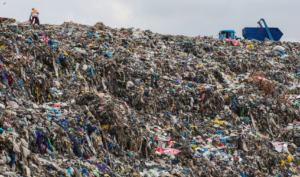“Designers haven’t acknowledged their role in causing environmental crises or their responsibility to address it & haven’t changed their practices to reflect it”
Designers play a crucial role in shaping the products, systems & experiences that define the living environment. Many people argue that they haven’t acknowledged their responsibility in contributing to environmental degradation – this is specifically because of the fact that design decisions often prioritize aesthetics & marketability over sustainability. A 2019 study highlighted that most product design processes follow the

model take -> make -> dispose – there’s only a small percentage of companies which actively design products for repair/reuse. A study by Ellen MacArthur Foundation (2017) emphasized that 85% of textiles end up in landfills – highlighting how much design choices in materials contribute to waste & pollution.
(Pictured right) A mountain of waste at the Kpone landfill site in Tema, Ghana (n.d.) – Nipah Dennis, Getty Images.
In recent years, artists & designers have adopted the digital field as a way of producing work – however, not many people realize the carbon footprint that digital media really has. The storage that data centers harbour consumes a lot of energy as the electricity required to run them are responsible for 1% of the global electricity use according to a  2021 study. Turning to digital media when traditional media has always been harmful – using toxic art materials such as oils, acrylics & resins may be doing the same amount of harm if not more. I think that because designers aren’t truly seeing the impact they’re making on the Earth, they aren’t prepared to accept responsiblity in these situations. Many designers shift their responsibility to manufacturers for environmental issues, blaming corporations & consumer demand – in a more profit-driven industry, it makes sense why these sustainable materials aren’t being introduced, more sustainable materials = higher cost = less profit.
2021 study. Turning to digital media when traditional media has always been harmful – using toxic art materials such as oils, acrylics & resins may be doing the same amount of harm if not more. I think that because designers aren’t truly seeing the impact they’re making on the Earth, they aren’t prepared to accept responsiblity in these situations. Many designers shift their responsibility to manufacturers for environmental issues, blaming corporations & consumer demand – in a more profit-driven industry, it makes sense why these sustainable materials aren’t being introduced, more sustainable materials = higher cost = less profit.
(Pictured left) Sketch of paintbrush pot (2024), Natalie Foster.
It’s fair to say that the design industry as a whole has been slow to embrace its responsibility environmentally, it’s that many designers are working to address these issues – however it’s a small amount. The future of design & the environment may depend on how quickly & broadly these sustainable practices are put into action.
As an artist myself, these facts were quite eye opening when I was researching. I specifically didn’t know about the way that digital artistry is affecting the planet massively – learning these details definitely has reshaped my mindset into how to produce my work in the future & how to be more environmentally conscious with both traditional & digital media. I find it very ironic that artists can produce such beautiful work inspired by the greatness of the environment specifically with tools that can destroy it.
‘The Story of Stuff’ explores a linear system within material goods. It focusses on the process of extraction, production, distribution, consumption & disposal. It argues that this system is very unsustainable & asks for a more sustainable way of living – emphasizing reduce, reuse & recycling. I think that a more circular system, as seen in Cradle-to-Cradle, is a much more beneficial cycle compared to a linear process – we will be the ones living in the future we have created, so we need to fully think about the present & how we design things.
distribution, consumption & disposal. It argues that this system is very unsustainable & asks for a more sustainable way of living – emphasizing reduce, reuse & recycling. I think that a more circular system, as seen in Cradle-to-Cradle, is a much more beneficial cycle compared to a linear process – we will be the ones living in the future we have created, so we need to fully think about the present & how we design things.
The Story of Stuff (2007), Annie Leonard.
__
Gueye, S. (2021). The trends and trailblazers creating a circular economy for fashion. [online] www.ellenmacarthurfoundation.org. Available at: https://www.ellenmacarthurfoundation.org/articles/the-trends-and-trailblazers-creating-a-circular-economy-for-fashion.
Roundy, J. (2023). Assess the Environmental Impact of Data Centers | TechTarget. [online] Data Center. Available at: https://www.techtarget.com/searchdatacenter/feature/Assess-the-environmental-impact-of-data-centers.
The Story of Stuff Project (2009). The Story of Stuff. YouTube. Available at: https://www.youtube.com/watch?v=9GorqroigqM.



